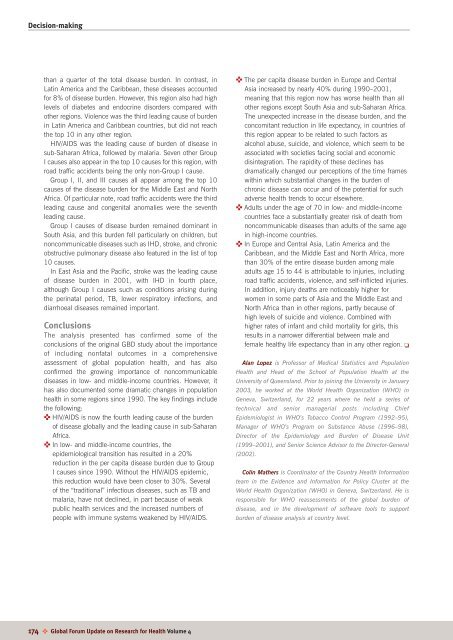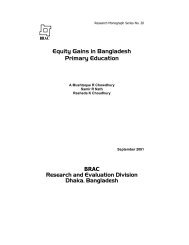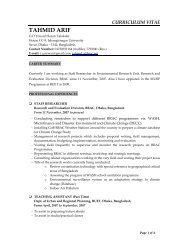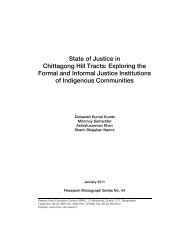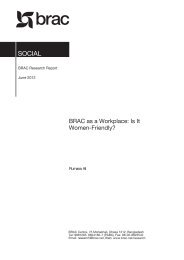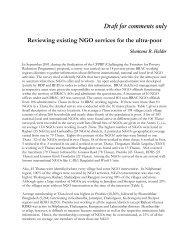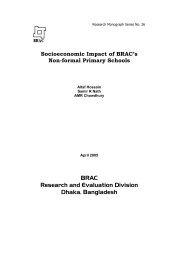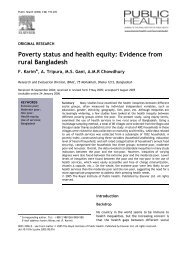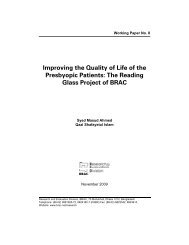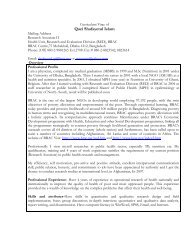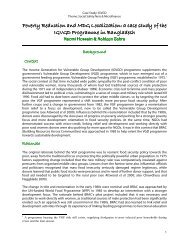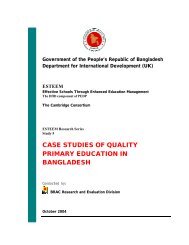Combining health and social protection measures to reach the ultra ...
Combining health and social protection measures to reach the ultra ...
Combining health and social protection measures to reach the ultra ...
You also want an ePaper? Increase the reach of your titles
YUMPU automatically turns print PDFs into web optimized ePapers that Google loves.
Decision-making<br />
than a quarter of <strong>the</strong> <strong>to</strong>tal disease burden. In contrast, in<br />
Latin America <strong>and</strong> <strong>the</strong> Caribbean, <strong>the</strong>se diseases accounted<br />
for 8% of disease burden. However, this region also had high<br />
levels of diabetes <strong>and</strong> endocrine disorders compared with<br />
o<strong>the</strong>r regions. Violence was <strong>the</strong> third leading cause of burden<br />
in Latin America <strong>and</strong> Caribbean countries, but did not <strong>reach</strong><br />
<strong>the</strong> <strong>to</strong>p 10 in any o<strong>the</strong>r region.<br />
HIV/AIDS was <strong>the</strong> leading cause of burden of disease in<br />
sub-Saharan Africa, followed by malaria. Seven o<strong>the</strong>r Group<br />
I causes also appear in <strong>the</strong> <strong>to</strong>p 10 causes for this region, with<br />
road traffic accidents being <strong>the</strong> only non-Group I cause.<br />
Group I, II, <strong>and</strong> III causes all appear among <strong>the</strong> <strong>to</strong>p 10<br />
causes of <strong>the</strong> disease burden for <strong>the</strong> Middle East <strong>and</strong> North<br />
Africa. Of particular note, road traffic accidents were <strong>the</strong> third<br />
leading cause <strong>and</strong> congenital anomalies were <strong>the</strong> seventh<br />
leading cause.<br />
Group I causes of disease burden remained dominant in<br />
South Asia, <strong>and</strong> this burden fell particularly on children, but<br />
noncommunicable diseases such as IHD, stroke, <strong>and</strong> chronic<br />
obstructive pulmonary disease also featured in <strong>the</strong> list of <strong>to</strong>p<br />
10 causes.<br />
In East Asia <strong>and</strong> <strong>the</strong> Pacific, stroke was <strong>the</strong> leading cause<br />
of disease burden in 2001, with IHD in fourth place,<br />
although Group I causes such as conditions arising during<br />
<strong>the</strong> perinatal period, TB, lower respira<strong>to</strong>ry infections, <strong>and</strong><br />
diarrhoeal diseases remained important.<br />
Conclusions<br />
The analysis presented has confirmed some of <strong>the</strong><br />
conclusions of <strong>the</strong> original GBD study about <strong>the</strong> importance<br />
of including nonfatal outcomes in a comprehensive<br />
assessment of global population <strong>health</strong>, <strong>and</strong> has also<br />
confirmed <strong>the</strong> growing importance of noncommunicable<br />
diseases in low- <strong>and</strong> middle-income countries. However, it<br />
has also documented some dramatic changes in population<br />
<strong>health</strong> in some regions since 1990. The key findings include<br />
<strong>the</strong> following:<br />
✜ HIV/AIDS is now <strong>the</strong> fourth leading cause of <strong>the</strong> burden<br />
of disease globally <strong>and</strong> <strong>the</strong> leading cause in sub-Saharan<br />
Africa.<br />
✜ In low- <strong>and</strong> middle-income countries, <strong>the</strong><br />
epidemiological transition has resulted in a 20%<br />
reduction in <strong>the</strong> per capita disease burden due <strong>to</strong> Group<br />
I causes since 1990. Without <strong>the</strong> HIV/AIDS epidemic,<br />
this reduction would have been closer <strong>to</strong> 30%. Several<br />
of <strong>the</strong> “traditional” infectious diseases, such as TB <strong>and</strong><br />
malaria, have not declined, in part because of weak<br />
public <strong>health</strong> services <strong>and</strong> <strong>the</strong> increased numbers of<br />
people with immune systems weakened by HIV/AIDS.<br />
✜ The per capita disease burden in Europe <strong>and</strong> Central<br />
Asia increased by nearly 40% during 1990–2001,<br />
meaning that this region now has worse <strong>health</strong> than all<br />
o<strong>the</strong>r regions except South Asia <strong>and</strong> sub-Saharan Africa.<br />
The unexpected increase in <strong>the</strong> disease burden, <strong>and</strong> <strong>the</strong><br />
concomitant reduction in life expectancy, in countries of<br />
this region appear <strong>to</strong> be related <strong>to</strong> such fac<strong>to</strong>rs as<br />
alcohol abuse, suicide, <strong>and</strong> violence, which seem <strong>to</strong> be<br />
associated with societies facing <strong>social</strong> <strong>and</strong> economic<br />
disintegration. The rapidity of <strong>the</strong>se declines has<br />
dramatically changed our perceptions of <strong>the</strong> time frames<br />
within which substantial changes in <strong>the</strong> burden of<br />
chronic disease can occur <strong>and</strong> of <strong>the</strong> potential for such<br />
adverse <strong>health</strong> trends <strong>to</strong> occur elsewhere.<br />
✜ Adults under <strong>the</strong> age of 70 in low- <strong>and</strong> middle-income<br />
countries face a substantially greater risk of death from<br />
noncommunicable diseases than adults of <strong>the</strong> same age<br />
in high-income countries.<br />
✜ In Europe <strong>and</strong> Central Asia, Latin America <strong>and</strong> <strong>the</strong><br />
Caribbean, <strong>and</strong> <strong>the</strong> Middle East <strong>and</strong> North Africa, more<br />
than 30% of <strong>the</strong> entire disease burden among male<br />
adults age 15 <strong>to</strong> 44 is attributable <strong>to</strong> injuries, including<br />
road traffic accidents, violence, <strong>and</strong> self-inflicted injuries.<br />
In addition, injury deaths are noticeably higher for<br />
women in some parts of Asia <strong>and</strong> <strong>the</strong> Middle East <strong>and</strong><br />
North Africa than in o<strong>the</strong>r regions, partly because of<br />
high levels of suicide <strong>and</strong> violence. Combined with<br />
higher rates of infant <strong>and</strong> child mortality for girls, this<br />
results in a narrower differential between male <strong>and</strong><br />
female <strong>health</strong>y life expectancy than in any o<strong>the</strong>r region. ❏<br />
Alan Lopez is Professor of Medical Statistics <strong>and</strong> Population<br />
Health <strong>and</strong> Head of <strong>the</strong> School of Population Health at <strong>the</strong><br />
University of Queensl<strong>and</strong>. Prior <strong>to</strong> joining <strong>the</strong> University in January<br />
2003, he worked at <strong>the</strong> World Health Organization (WHO) in<br />
Geneva, Switzerl<strong>and</strong>, for 22 years where he held a series of<br />
technical <strong>and</strong> senior managerial posts including Chief<br />
Epidemiologist in WHO’s Tobacco Control Program (1992–95),<br />
Manager of WHO’s Program on Substance Abuse (1996–98),<br />
Direc<strong>to</strong>r of <strong>the</strong> Epidemiology <strong>and</strong> Burden of Disease Unit<br />
(1999–2001), <strong>and</strong> Senior Science Advisor <strong>to</strong> <strong>the</strong> Direc<strong>to</strong>r-General<br />
(2002).<br />
Colin Ma<strong>the</strong>rs is Coordina<strong>to</strong>r of <strong>the</strong> Country Health Information<br />
team in <strong>the</strong> Evidence <strong>and</strong> Information for Policy Cluster at <strong>the</strong><br />
World Health Organization (WHO) in Geneva, Switzerl<strong>and</strong>. He is<br />
responsible for WHO reassessments of <strong>the</strong> global burden of<br />
disease, <strong>and</strong> in <strong>the</strong> development of software <strong>to</strong>ols <strong>to</strong> support<br />
burden of disease analysis at country level.<br />
174 ✜ Global Forum Update on Research for Health Volume 4


